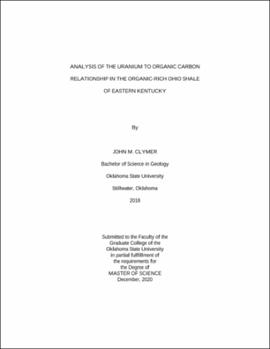| dc.contributor.advisor | Riedinger, Natascha | |
| dc.contributor.author | Clymer, John M. | |
| dc.date.accessioned | 2021-05-25T20:42:34Z | |
| dc.date.available | 2021-05-25T20:42:34Z | |
| dc.date.issued | 2020-12 | |
| dc.identifier.uri | https://hdl.handle.net/11244/329991 | |
| dc.description.abstract | Organic-rich shales have become increasingly important to unconventional petroleum reservoirs, and tools such as the gamma-ray have been used to locate them due to the radioactivity of elements such as uranium, potassium, and thorium present within shales. Complex sedimentary processes of organic-rich black shales are responsible for highly variable geochemical signals. Generally, there is a strong correlation between gamma-ray signature, as a result of radioactive uranium (U), and total organic carbon (TOC) in many Devonian black shales due to similar depositional processes of U and TOC. However, this strong correlation between U and TOC does not seem to be present within the Cleveland Shale interval based on gamma-ray data. | |
| dc.description.abstract | In order to interpret ancient ocean conditions, trace metal uranium and molybdenum (Mo), and total organic carbon inventory of the Cleveland Shale and Lower Huron members of the Devonian Ohio Shale Group of eastern Kentucky were evaluated in order to determine the degree of basin restriction and paleoredox state of the Appalachian Basin at the time of deposition. The Ohio Shale Group provides a remarkable study area for this investigation along the basin margin of the Appalachian Basin, as trace metal U and Mo data give insight on the opening and closing of the basin throughout the Devonian Period. The Cleveland member of the Ohio Shale Group displays a weak to moderate correlation between TOC and trace metal U and Mo. In contrast, the two subdivisions that are defined in this study of the Lower Huron of the same stratigraphic group has a much stronger correlation between TOC and trace metal U and Mo. In fact, many sections throughout the lower and uppermost Cleveland Shale interval have greater organic carbon contents (up to 6.0 wt.%) than that of sections in the Lower Huron that have more radioactivity as a result of higher U contents. This discrepancy between U, Mo, and organic carbon accumulation along the basin margin setting is a result of trace metal availability in the water column, basin geometry, location within the basin, and a fluctuating sea level that impacted the degree of restriction and sill depth dividing the water masses surrounding the Appalachian Basin. | |
| dc.format | application/pdf | |
| dc.language | en_US | |
| dc.rights | Copyright is held by the author who has granted the Oklahoma State University Library the non-exclusive right to share this material in its institutional repository. Contact Digital Library Services at lib-dls@okstate.edu or 405-744-9161 for the permission policy on the use, reproduction or distribution of this material. | |
| dc.title | Analysis of the uranium to organic carbon relationship in the organic-rich Ohio Shale of eastern Kentucky | |
| dc.contributor.committeeMember | Puckette, James | |
| dc.contributor.committeeMember | Pashin, Jack | |
| osu.filename | Clymer_okstate_0664M_16986.pdf | |
| osu.accesstype | Open Access | |
| dc.type.genre | Thesis | |
| dc.type.material | Text | |
| dc.subject.keywords | black shale | |
| dc.subject.keywords | devonian | |
| dc.subject.keywords | kentucky | |
| dc.subject.keywords | ohio shale | |
| dc.subject.keywords | total organic carbon | |
| dc.subject.keywords | uranium | |
| thesis.degree.discipline | Geology | |
| thesis.degree.grantor | Oklahoma State University | |
